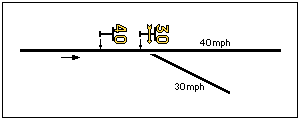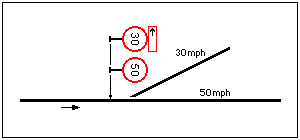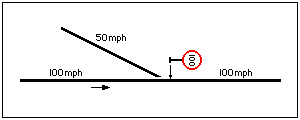|
|
|
In the beginning, locomotives were not equipped with speedometers, and lineside speed signs were only installed by exception. The locations of any permanent speed restrictions (PSRs) were detailed in appendices to the working timetables, latterly issued as a separate document called the "Sectional Appendix". Drivers relied heavily on their own experience and familiarity with the railway to be able to judge their speed and observe any speed restrictions.
Outside of those specific locations where permanent speed restrictions were in force, no upper speed limit was specified until after the Second World War, when each railway line was assigned a "maximum permissible speed" as was laid out in the relevant appendix. The maximum permissible speed was not necessarily constant along the whole length of the railway. Usually, no lineside speed sign was provided at places where it increased or decreased.
Following a fatal derailment at Sutton Coldfield on 23 January 1955, British Railways made a decision to extend, throughout its entire network, the former LNER practice of installing lineside speed signs at the beginning of all permanent speed restrictions.

|
| Fig. 1: Permanent Speed Restriction. |
|---|
Normally, no sign was installed at the end of a PSR (i.e. at the place where maximum permissible speed may be resumed), except where one PSR was immediately followed by another of a different speed.

|
| Fig. 2: Abutting Permanent Speed Restrictions. |
|---|
From June 1961, speed signs were being provided on the Great Eastern electrified lines (between London Liverpool Street and Clacton-on-Sea etc.) at every place where the maximum permissible speed changed or resumed (i.e. at the end of a PSR). Similar provision was made on the Main and Fast lines between London Euston and Manchester and Liverpool in April 1966, and in 1971, the practice was adopted as standard on all lines where the maximum permissible speed was 90 mph or higher. Drivers on these lines would therefore see a lineside speed sign at each place where the permitted speed changed. This formed the basis of what was termed "continuous route signing", which aided route learning. Current practice is to install a speed sign at every location where the permitted speed changes, irrespective of the upper limit. The term "continuous route signing" is no longer used, however. Sectional Appendices issued from the 1990s onwards make no distinction between maximum permissible speed and permanent speed restrictions, but they present a continuous picture of permitted speeds along the railway.
Railways that operate exclusively with cab signalling are not provided with lineside speed restriction signs, except where required for degraded operation.
A speed restriction sign applicable to a diverging line is fitted with an arrow sign pointing left or right as appropriate. A single sign with two arrows is provided if there are equal speed divergences on both sides in close proximity. Signs were not generally provided at junctions between parallel lines or at the entrance or exit of loops or platform lines, etc., where a standard speed restriction of 15 mph applied unless otherwise indicated.

|
| Fig. 3: Permanent Speed Restrictions on Diverging Routes. |
|---|
If there was also a reduction in speed on the straight route commencing at the diverging junction, a separate sign was installed about 40 yards (36 metres) on approach to the sign for the diverging route.

|
| Fig. 4: Permanent Speed Restrictions on Diverging Route and Straight Route. |
|---|
Since 1996 it has been practice to site the two signs side by side.

|
| Fig. 5: Permanent Speed Restrictions on Diverging Route and Straight Route. |
|---|
A memorandum issued by the British Railways Board's Director of Operations in February 1988 outlined an enhanced form of continuous route signing, a feature of which was the provision of a reminder sign where a converging line joined a higher speed route. Reminder signs, which are usually in miniature form, do not denote a change of permissible speed for trains proceeding straight along the higher speed route, the drivers of which may disregard them.

|
| Fig. 6: Permissible Speed Reminder Sign for Converging Line. |
|---|
Differential speed restrictions specify different permissible speeds for different types of trains and are categorised as 'standard' or 'non-standard'.
A standard differential speed restriction comprises a pair of permissible speeds conforming to the following standard applications:
A non-standard differential speed restriction indicates a variation to the permissible speed that is applicable only to the type of train denoted by letters on the relevant sign (e.g. "HST" for High Speed Trains, as in the examples that follow).
Figure 7 illustrates an earlier method of signing non-standard differential speeds. Under this method, a distinctive commencement sign (coloured yellow) is installed at the start of each portion of line where a higher speed applies. A commencement sign may be co-located with an ordinary PSR sign (as shown at "A") or installed independently (as shown at "B"). On passing a commencement sign, drivers of HSTs may disregard any ordinary signs indicating a lower speed, including any further signs ahead (as shown at "C"). Ordinary speed restriction signs indicating a higher speed continue to apply. The higher speeds apply until a termination sign is reached; this can either be installed independently or co-located with an ordinary PSR sign (as shown at "D").

|
| Fig. 7: Non-standard Differential Speed Restrictions. |
|---|
Figure 8 illustrates the same piece of railway as figure 7, but in this example the non-standard differential speeds are signed in accordance with current standards. In addition to having a different appearance, the manner in which these signs are provided also differs. Crucially, they do not override any subsequent signs indicating a lower speed, hence the need for a second "HST70" sign co-located with the "50" sign at "C" and also the absence of a termination sign at "D".

|
| Fig. 8: Non-standard Differential Speed Restrictions. |
|---|
Up to a maximum of three different speeds may be displayed on signs at any one position, i.e.:
The Southern Region of British Rail operated a busy network with an intensive passenger service, which needed signals to be closely spaced to satisfy headway requirements. However, this presented a potential problem for freight trains, since they would have to run at reduced speeds to be able to brake within the shorter braking distances available. In May 1980, the Southern Region therefore introduced a rule that freight trains must run at no more than two thirds of the maximum permissible speed applicable to passenger trains. This was known as the "two thirds" rule, and it applied throughout the Southern Region. No reduction in speed was required where the maximum permissible speed was less than 30 mph. Drivers of freight trains were still required to obey any lower signed permanent speed restrictions.
Since 2001, efforts have been ongoing to gradually abolish the "two thirds" rule as lines on the former Southern Region are resignalled and signs showing differential speeds (which were not in common use when the rule was introduced) are installed.
|